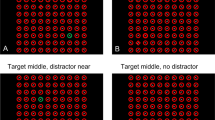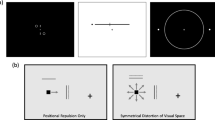Abstract
The proposal that peripheral visual changes (cues) tend to summon attention automatically was tested by studying the effect of peripheral cueing on simple detection latency. Delay between cue onset and target onset, the contingent relationship between cue location and target location, and instructions to subjects were manipulated. Results showed that a peripheral display change could capture attention even when the target was far more likely to appear at an uncued location. When subjects were explicitly informed that targets were likely to appear away from the cued location they were able to suppress this effect, but were unable completely to reverse it by rapidly orienting attention towards the uncued side. Hence the process appears to be automatic in the sense that it occurs unless there are explicit instructions to the contrary. With explicit instructions the processing operation can be suppressed, but not completely reversed.
Similar content being viewed by others
References
Eriksen, C.W., & Yeh, Y-Y. (1985). Allocation of attention in the visual field.Journal of Experimental Psychology: Human Perception and Performance, 11, 583–597.
Jonides, J. (1981). Voluntary versus automatic control over the mind’s eye’s movement. In J. Long & A. Baddeley (Eds.),Attention and Performance IX. Hillsdale, NJ: Erlbaum.
Jonides, J., & Mack, R. (1984). On the cost and benefit of cost and benefit.Psychological Bulletin, 96, 29–44.
Kahneman, D., & Treisman, A. (1984). Changing views of attention aand automaticity. In D. R. Davies and R. Parasuraman (Eds.),Varieties of Attention. New York: Academic Press.
Maylor, E., & Hockey, G.R.J. (1985). Inhibitory component of externally controlled covert orienting in visual space.Journal of Experimental Psychology: Human Perception and Performance, 11, 777–787.
Paap, K.R., & Ogden, W.C. (1981). Letter encoding is an obligatory but capacity demanding operation.Journal of Experimental Psychology: Human Perception and Performance, 7, 518–527.
Posner, M.I. (1980). Orienting of attention.Quarterly Journal of Experimental Psychology, 32, 3–25.
Posner, M.I., & Cohen, Y. (1984). Components of visual orienting. In D. Bouma and D. Bouwhuis (Eds.),Attention and Performance X. Hillsdale, NJ: Erlbaum.
Posner, M.I., Cohen, Y., Choate, L., Maylor, L. & Hockey, G.R.J. (1984). Sustained concentration: Passive filtering or active orienting? In S. Kornblum & J. Requin (Eds.),Preparatory States and Processes. Hillsdale. NJ: Erlbaum.
Posner, M.I., Cohen, Y., & Rafal, R. (1982). Neural systems control of spatial orienting.Philosophical Transactions of the Royal Society of London B, 298, 187–198.
Posner, M.I., Nissen, M.J., & Ogden, W.C. (1978). Attended and unattended processing modes: The role of set for spatial location. In H. Pick & I. Saltzman (Eds.),Modes of Perceiving and Processing Information. Hillsdale, NJ: Erlbaum.
Posner, M.I., Snyder, C.R., & Davidson, B.J. (1980). Attention and the detection of signals.Journal of Experimental Psychology: General, 109, 160–174.
Shaw, M., & Shaw, P. (1977). Optimal allocation of cognitive resources to spatial locations.Journal of Experimental Psychology: Human Perception and Performance, 3, 201–211.
Author information
Authors and Affiliations
Additional information
This work was supported by the U.K. Admiralty Research Establishment (Research Agreement No. 53482).
Rights and permissions
About this article
Cite this article
Lambert, A., Spencer, E. & Mohindra, N. Automaticity and the capture of attention by a peripheral display change. Current Psychology 6, 136–147 (1987). https://doi.org/10.1007/BF02686618
Accepted:
Published:
Issue Date:
DOI: https://doi.org/10.1007/BF02686618




